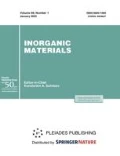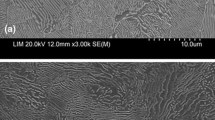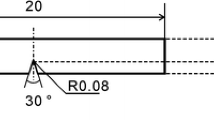Abstract
In the paper, the deformation features of the propagation of cleavage cracks in low-alloy low-carbon steel with a ferritic-pearlite microstructure by example of steel 09G2S after hot rolling are investigated. The studied cleavage cracks were obtained in impact bending tests at temperatures in the ductile to brittle transition interval. The study was carried out by transmission electron microscopy, transmission Kikuchi diffraction, and electron backscattered diffraction. It is shown that the deformation accompanying the growth of the cleavage crack in the ferritic-pearlite microstructure is formed when the joints between the cracks propagating in parallel planes break. The crack growth within a single plane occurs without any recorded deformation. The joints are broken by a ductile mechanism according to the scheme of mixed loading by opening and shear. Overlapping of the cleavage cracks determines the relationship between the shear mode and the opening mode during joint deformation, which controls the shape and depth of the plastic deformation zones.















Similar content being viewed by others
REFERENCES
Cottrell, A.H., Theory of brittle fracture in steel and similar metals, Trans. Metall. Soc. AIME, 1958, vol. 212, pp. 192–203.
Friedel, J., Dislocations, Oxford: Pergamon, 1964.
Rice, J.R. and Thomson, R., Ductile versus brittle behaviour of crystals, Philos. Mag., 1974, vol. 29, no. 1, pp. 73–97.https://doi.org/10.1080/14786437408213555
Rice, J.R., Beltz, G.E., and Sun, Y., Peierls framework for dislocation nucleation from a crack tip, in Topics in Fracture and Fatigue, New York: Springer, 1992, pp. 1–58.https://doi.org/10.1007/978-1-4612-2934-6_1
Shtremel’, M.A., Belyakov, B.G., and Belomyttsev, M.Yu., Dissipative structure of fracture, Dokl. Akad. Nauk SSSR, 1991, vol. 318, no. 1, pp. 105–111.
Qiao, Y. and Argon, A.S., Cleavage crack-growth-resistance of grain boundaries in polycrystalline Fe–2% Si alloy: experiments and modeling, Mech. Mater., 2003, vol. 35, nos. 1–2, pp. 129–154.https://doi.org/10.1016/S0167-6636(02)00194-1
Belomyttsev, M.Yu., Belyakov, B.G., and Shtremel’, M.A., Effect of temperature on molybdenum fracture processes, Izv. Akad. Nauk, Met., 1992, no. 2, pp. 200–206.
Belomyttsev, M.Yu., Structures and cleavage mechanisms observed in the BCC single crystals by the TEM method, Phys. Met. Metallogr., 2005, vol. 100, no. 5, pp. 500–508.
Nohava, J., Haušild, P., Karlık, M., and Bompard, P., Electron backscattering diffraction analysis of secondary cleavage cracks in a reactor pressure vessel steel, Mater. Character., 2002, vol. 49, no. 3, pp. 211–217.https://doi.org/10.1016/S1044-5803(02)00360-1
Naylor, J.P. and Krahe, P.R., Cleavage planes in lath type bainite and martensite, Metall. Trans. A, 1975, vol. 6, no. 3, pp. 594–599.
Mohseni, P., Solberg, J.K., Karlsen, M., Akselsen, O.M., and Ostby, E., Application of combined EBSD and 3D-SEM technique on crystallographic facet analysis of steel at low temperature, J. Microsc., 2013, vol. 251, no. 1, pp. 45–56.https://doi.org/10.1111/jmi.12041
Pineau, A., Benzerga, A.A., and Pardoen, T., Failure of metals I: Brittle and ductile fracture, Acta Mater., 2016, vol. 107, pp. 424–483.https://doi.org/10.1016/j.actamat.2015.12.034
Kong, X. and Qiao, Y., Crack trapping effect of persistent grain boundary islands, Fatigue Fract. Eng. Mater. Struct., 2005, vol. 28, no. 9, pp. 753–758.https://doi.org/10.1111/j.1460-2695.2005.00908.x
Qiao, Y. and Argon, A.S., Cleavage cracking resistance of high angle grain boundaries in Fe–3% Si alloy, Mech. Mater., 2003, vol. 35, nos. 3–6, pp. 313–331.https://doi.org/10.1016/S0167-6636(02)00284-3
Klevtsov, G.V., Plasticheskie zony i diagnostika razrusheniya metallicheskikh materialov (Plastic Zones and Fracture Diagnosis of Metallic Materials), Moscow: Mosk. Inst. Stali i Splavov, 1999.
Alexander, D.J. and Bernstein, I.M., The cleavage plane of pearlite, Metall. Trans. A, 1982, vol. 13, no. 10, pp. 1865–1868.
Imamura, S., Muramoto, H., Murata, Y., Shimada, Y., Kayamori, Y., and Tagawa, T., Crystallographic orientation analysis of cleavage facets adjacent to a fracture trigger in low carbon steel, Int. J. Fract., 2015, vol. 192, no. 2, pp. 253–257.https://doi.org/10.1007/s10704-015-0014-5
Karlík, M., Haušild, P., Prioul, C., and Stöger-Pollach, M., Microstructure of low alloyed steel close to the fracture surface, Mater. Sci. Eng., A, 2007, vol. 462, nos. 1–2, pp. 183–188.https://doi.org/10.1016/j.msea.2006.04.149
Trimby, P.W., Orientation mapping of nanostructured materials using transmission Kikuchi diffraction in the scanning electron microscope, Ultramicroscopy, 2012, vol. 120, pp. 16–24.https://doi.org/10.1016/j.ultramic.2012.06.004
Liang, X.Z., Dodge, M.F., Jiang, J., and Dong, H.B., Using transmission Kikuchi diffraction in a scanning electron microscope to quantify geometrically necessary dislocation density at the nanoscale, Ultramicroscopy, 2019, vol. 197, pp. 39–45.https://doi.org/10.1016/j.ultramic.2018.11.011
Kantor, M.M., Sudin, V.V., and Solntsev, K.A., Effect of the type and morphology of grain boundaries on stress corrosion cracking in low-alloy, low-carbon steel, Inorg. Mater., 2019, vol. 55, no. 4, pp. 409–416.https://doi.org/10.1134/S0020168519040083
Brewer, L.N., Field, D.P., and Merriman, C.C., Mapping and assessing plastic deformation using EBSD, in Electron Backscatter Diffraction in Materials Science, Boston: Springer, 2009, pp. 251–262.https://doi.org/10.1007/978-0-387-88136-2_18
Wang, Y., Wang, W., Zhang, B., and Li, C.Q., A review on mixed mode fracture of metals, Eng. Fract. Mech., 2020, paper 107126.https://doi.org/10.1016/j.engfracmech.2020.107126
Zhang, X.P., Dorn, L., and Shi, Y.W., Correlation of the microshear toughness and fracture toughness for pressure vessel steels and structural steels, Int. J. Pressure Vessels Piping, 2002, vol. 79, no. 6, pp. 445–450.https://doi.org/10.1016/S0308-0161(02)00032-7
Novak, J., Ductile fracture of ferritic steels: correlation of K IIc/K Ic ratio and strain hardening curve, ASME Pressure Vessels and Piping Conf., 2002, vol. 46547, pp. 131–135.https://doi.org/10.1115/PVP2002-1342
ACKNOWLEDGMENTS
We express our gratitude to M.A. Shtremel’, Professor of National Research Technological University Moscow Institute of Steel and Alloys (MISiS), Doctor of Physical and Mathematical Sciences, for a detailed discussion of the experimental results.
Funding
The work was carried out within the state task no. 075-00947-20-00.
Author information
Authors and Affiliations
Corresponding author
Rights and permissions
About this article
Cite this article
Kantor, M.M., Sudin, V.V. & Solncev, K.A. Deformation Features of the Propagation of Cleavage Cracks in a Ferritic-Pearlite Microstructure in the Ductile to Brittle Transition Interval. Inorg Mater 57, 641–653 (2021). https://doi.org/10.1134/S0020168521060042
Received:
Revised:
Accepted:
Published:
Issue Date:
DOI: https://doi.org/10.1134/S0020168521060042




